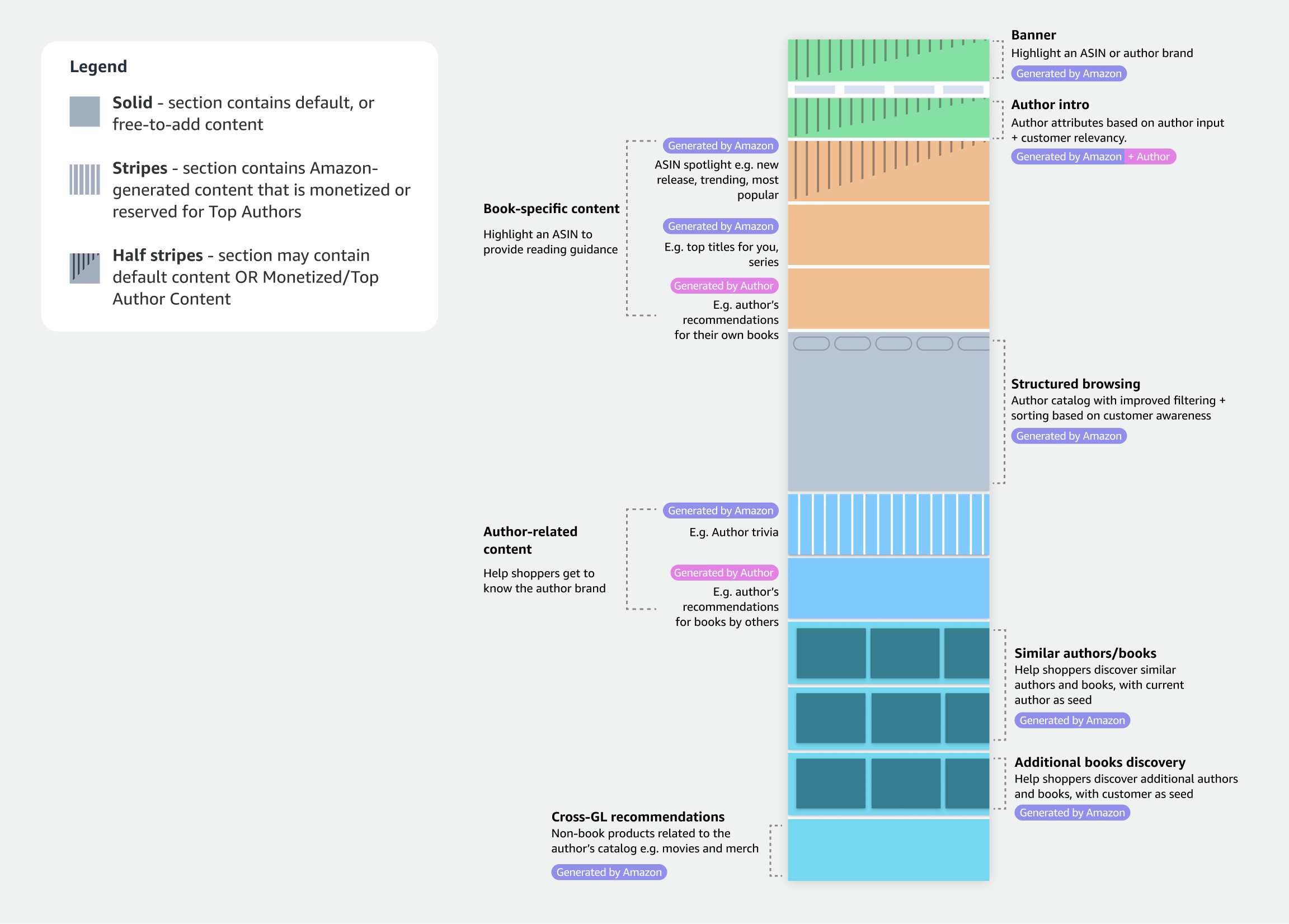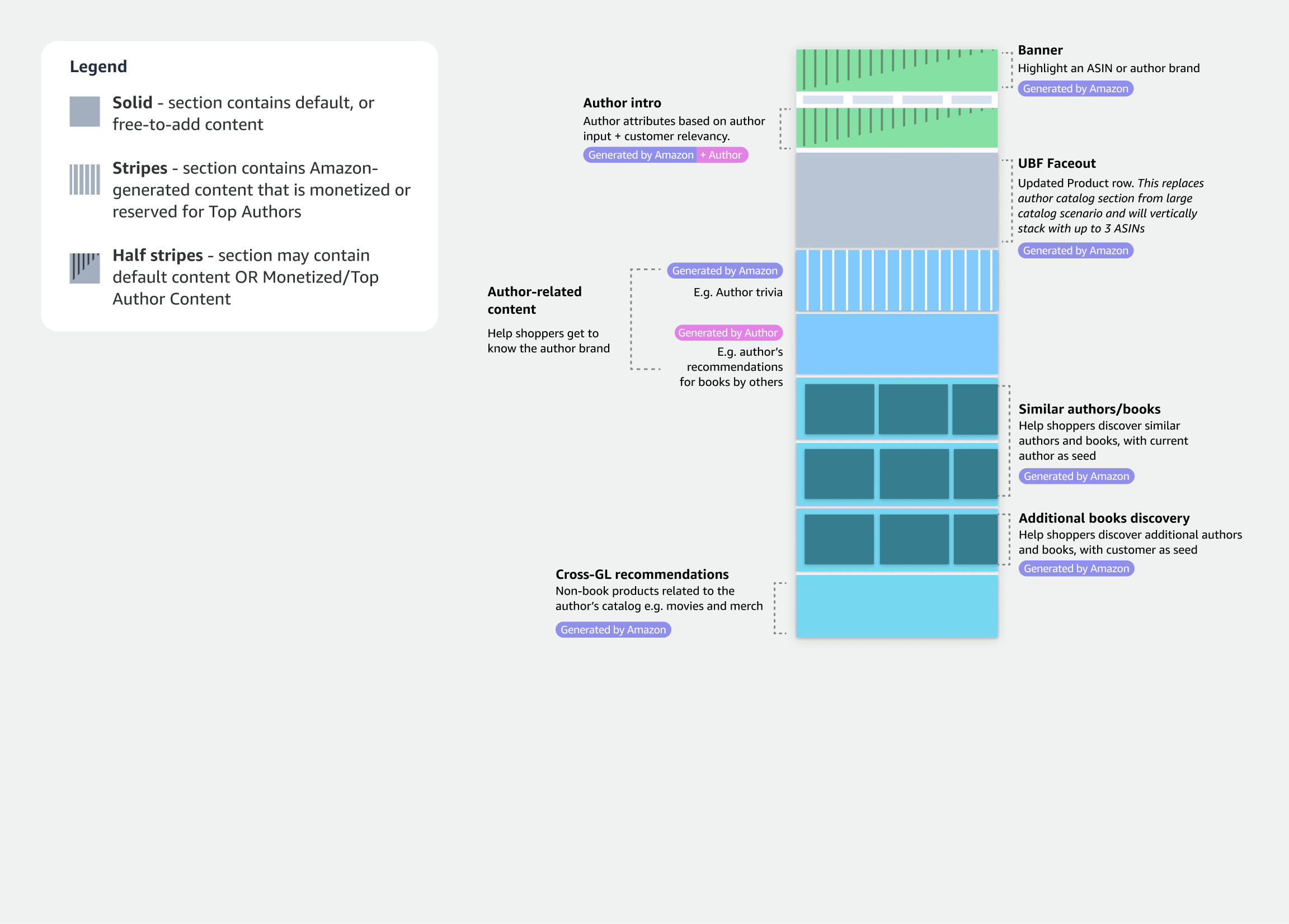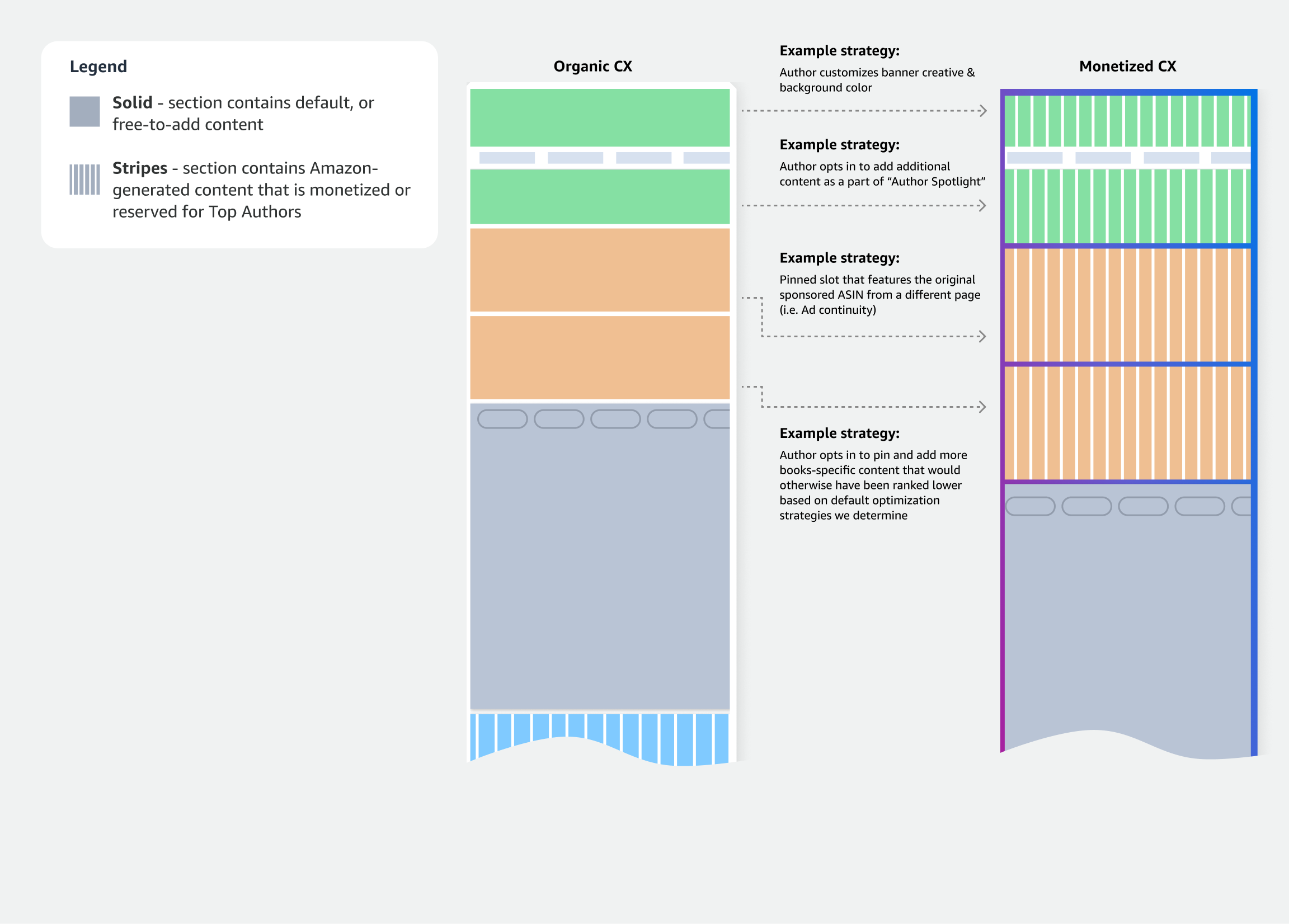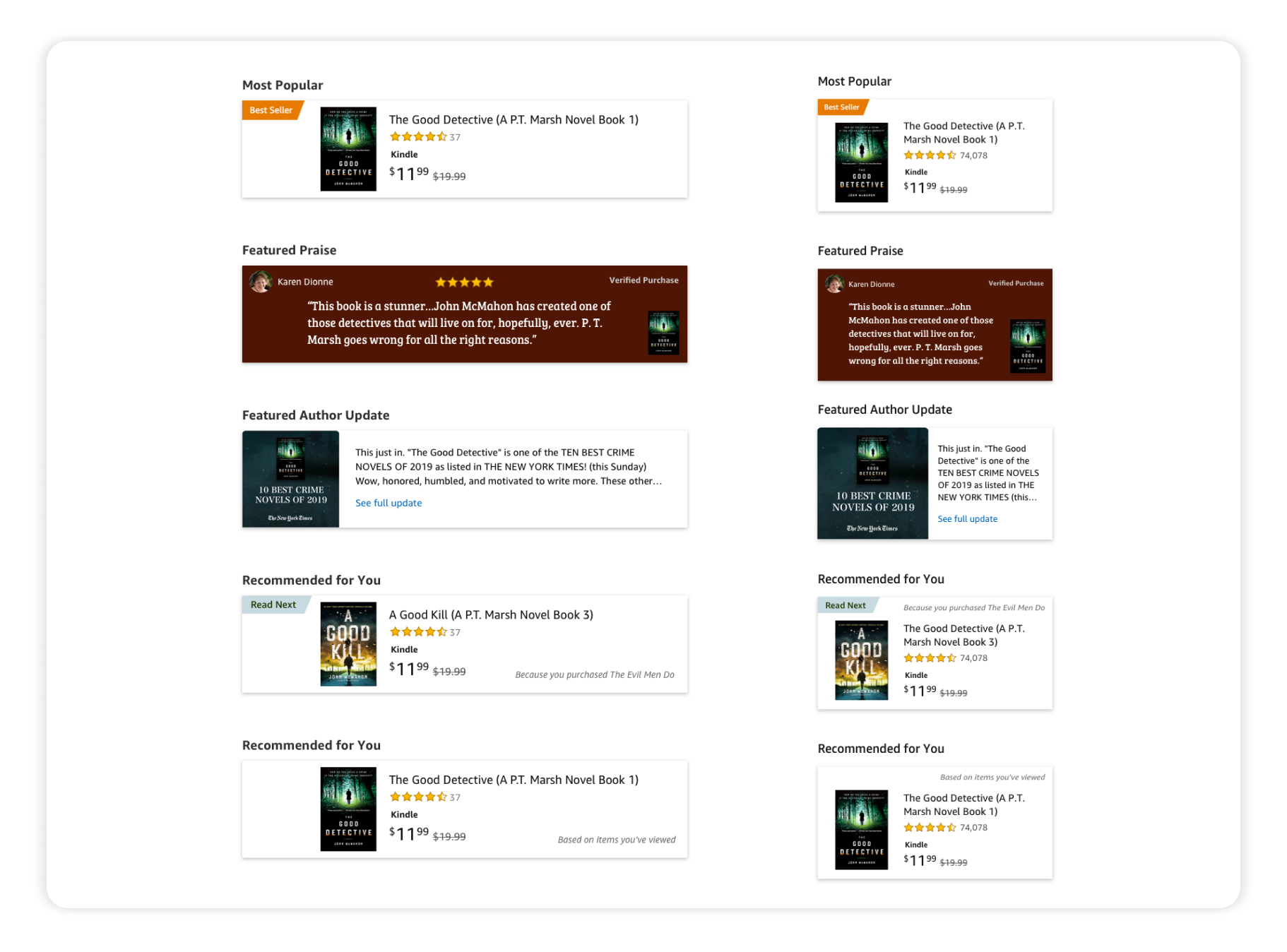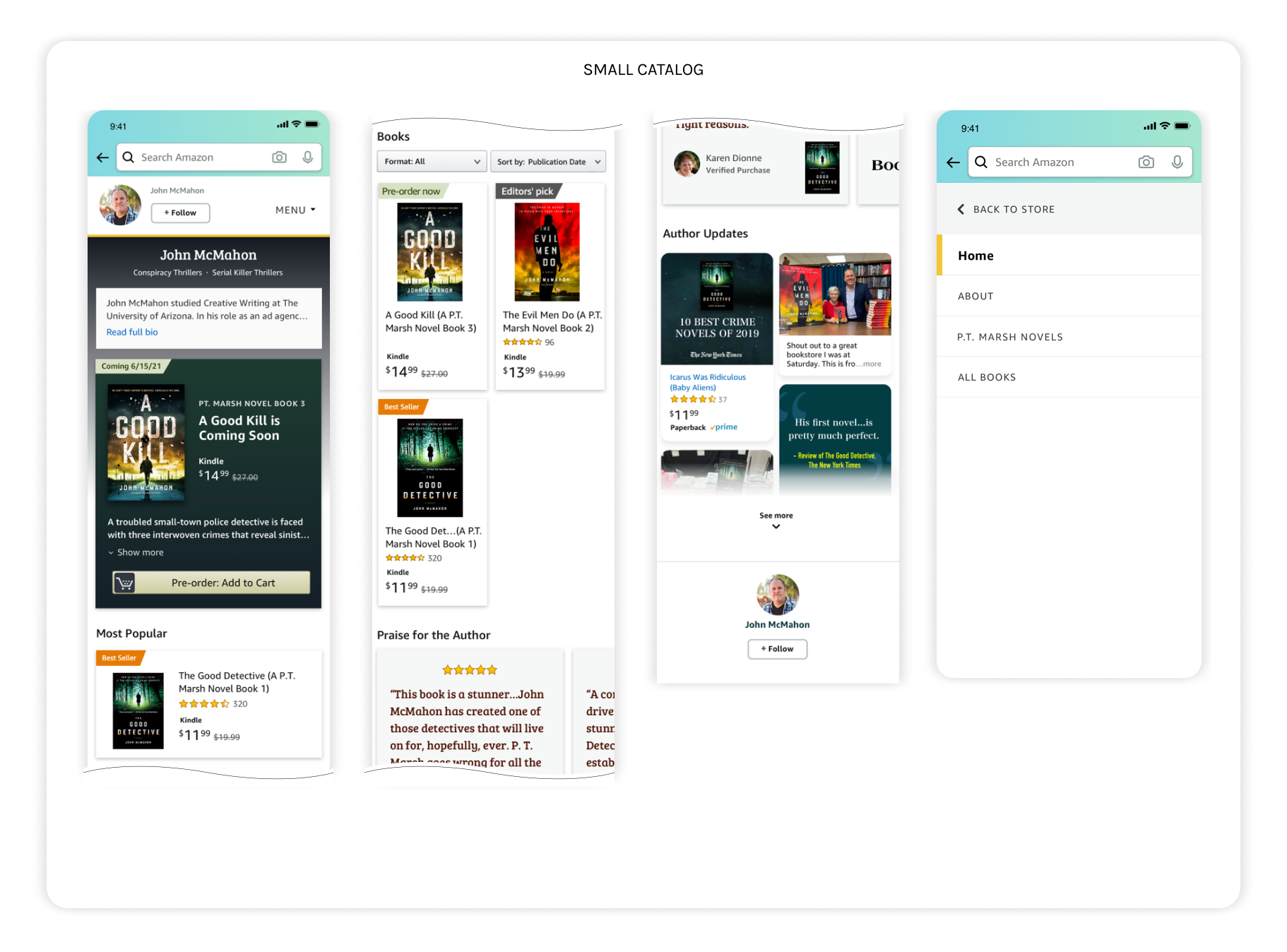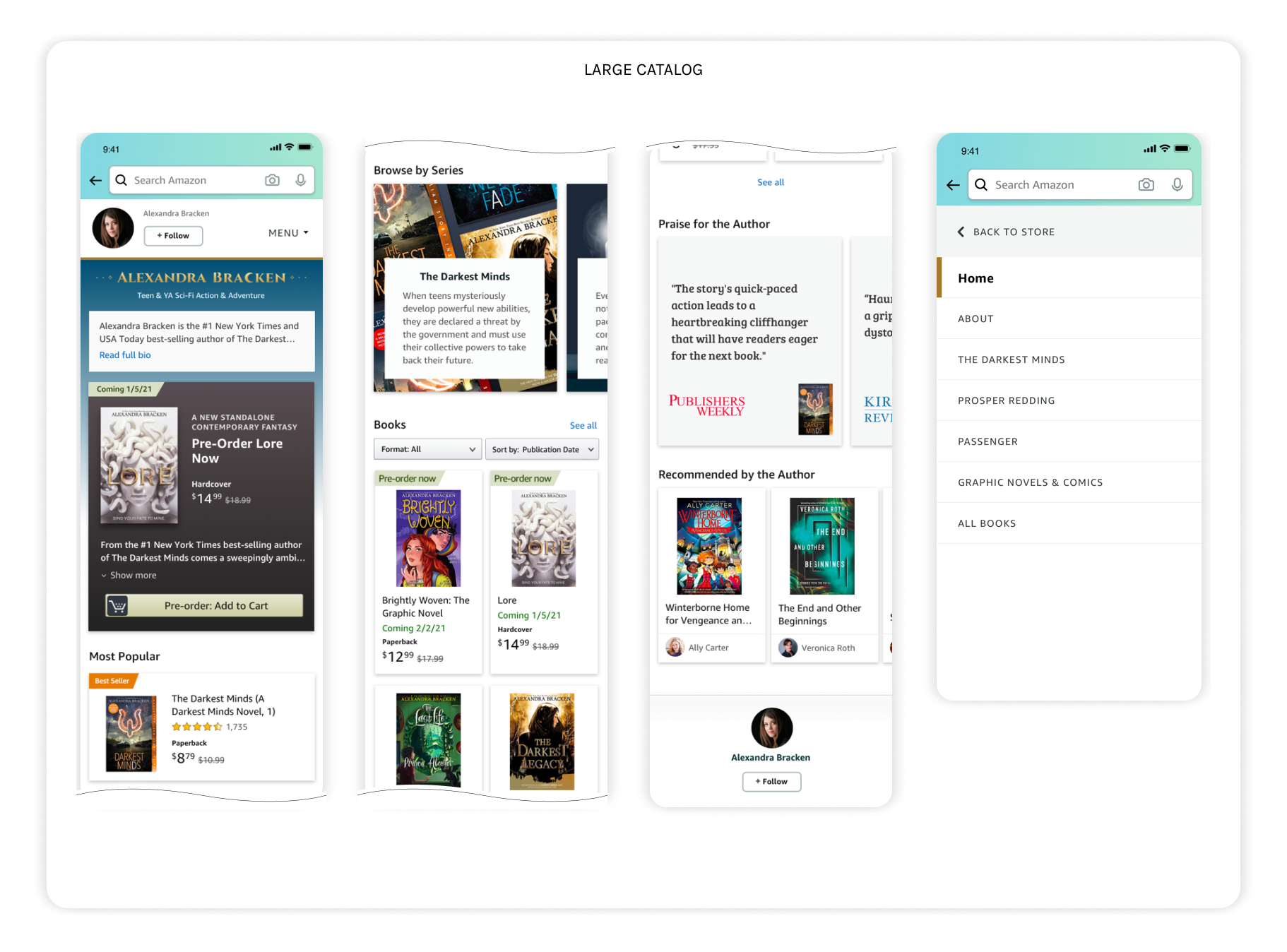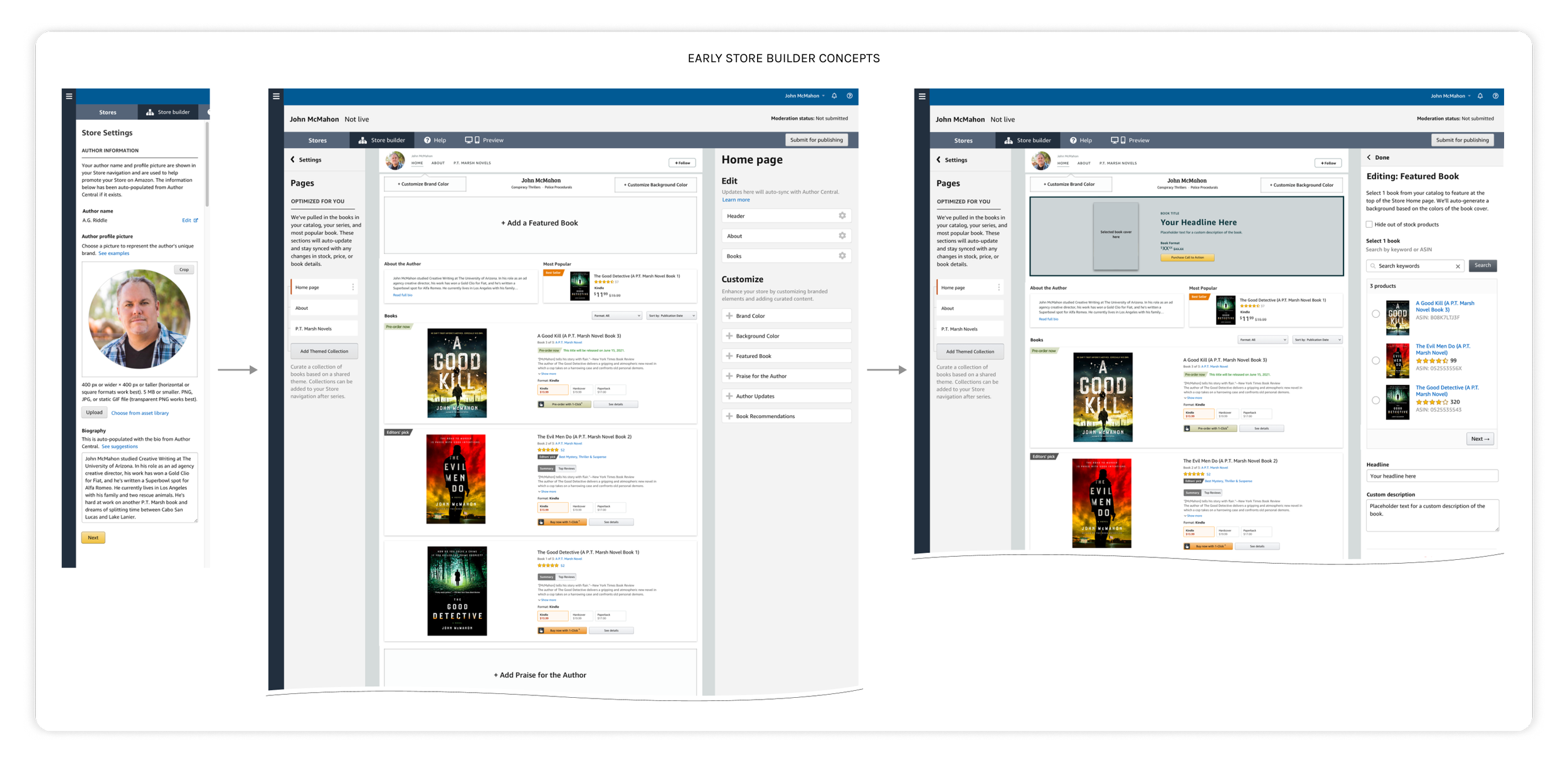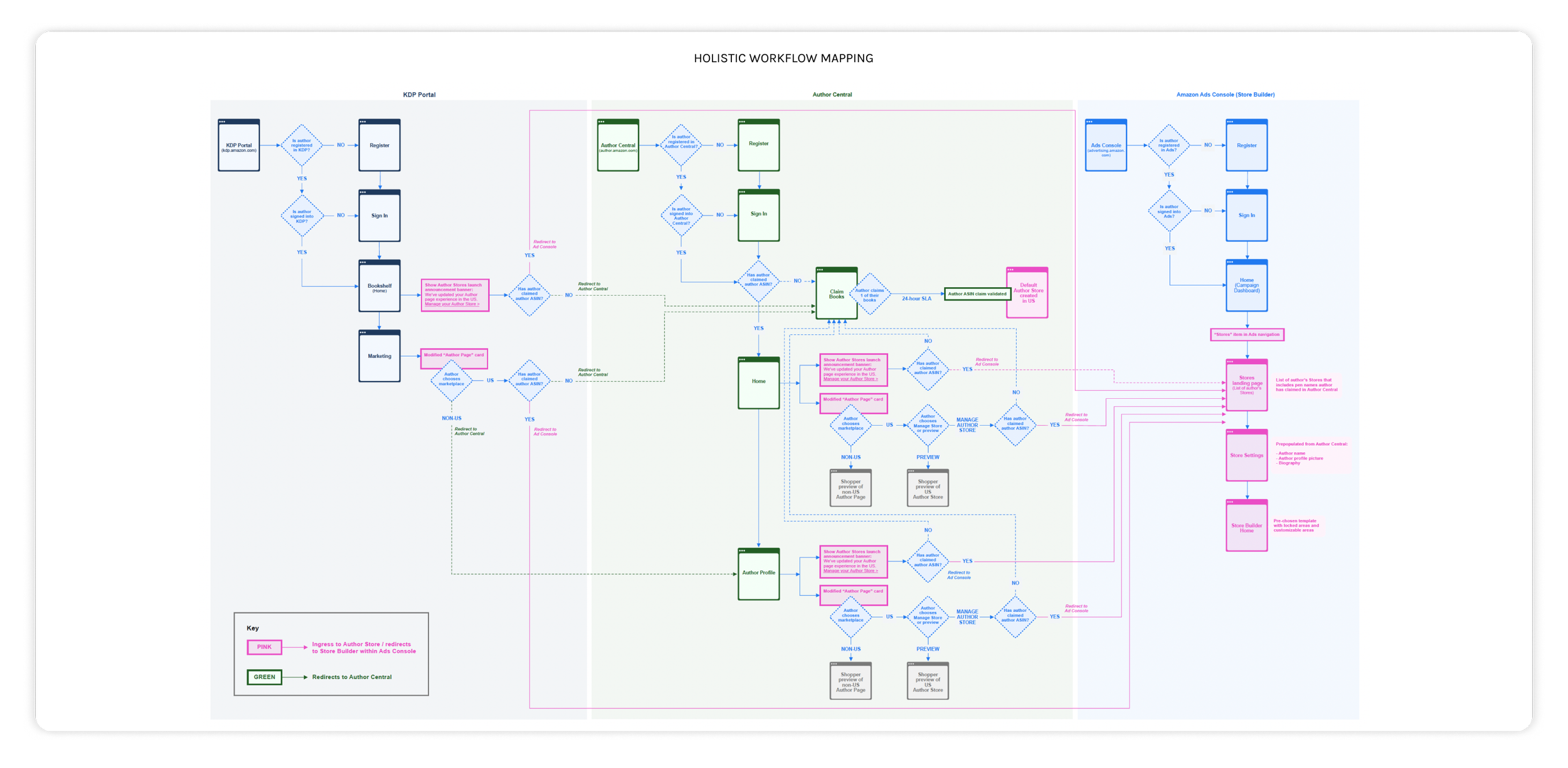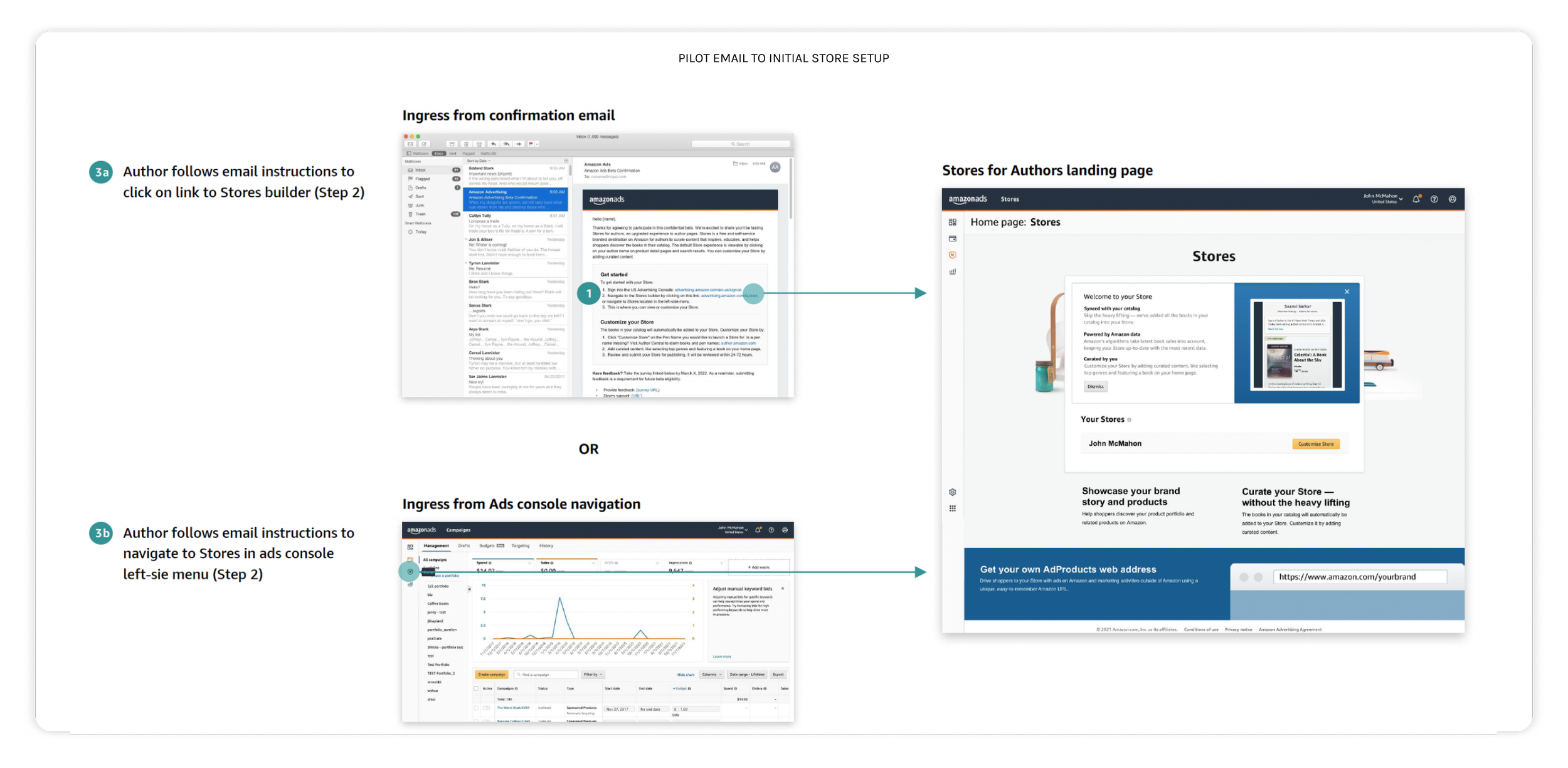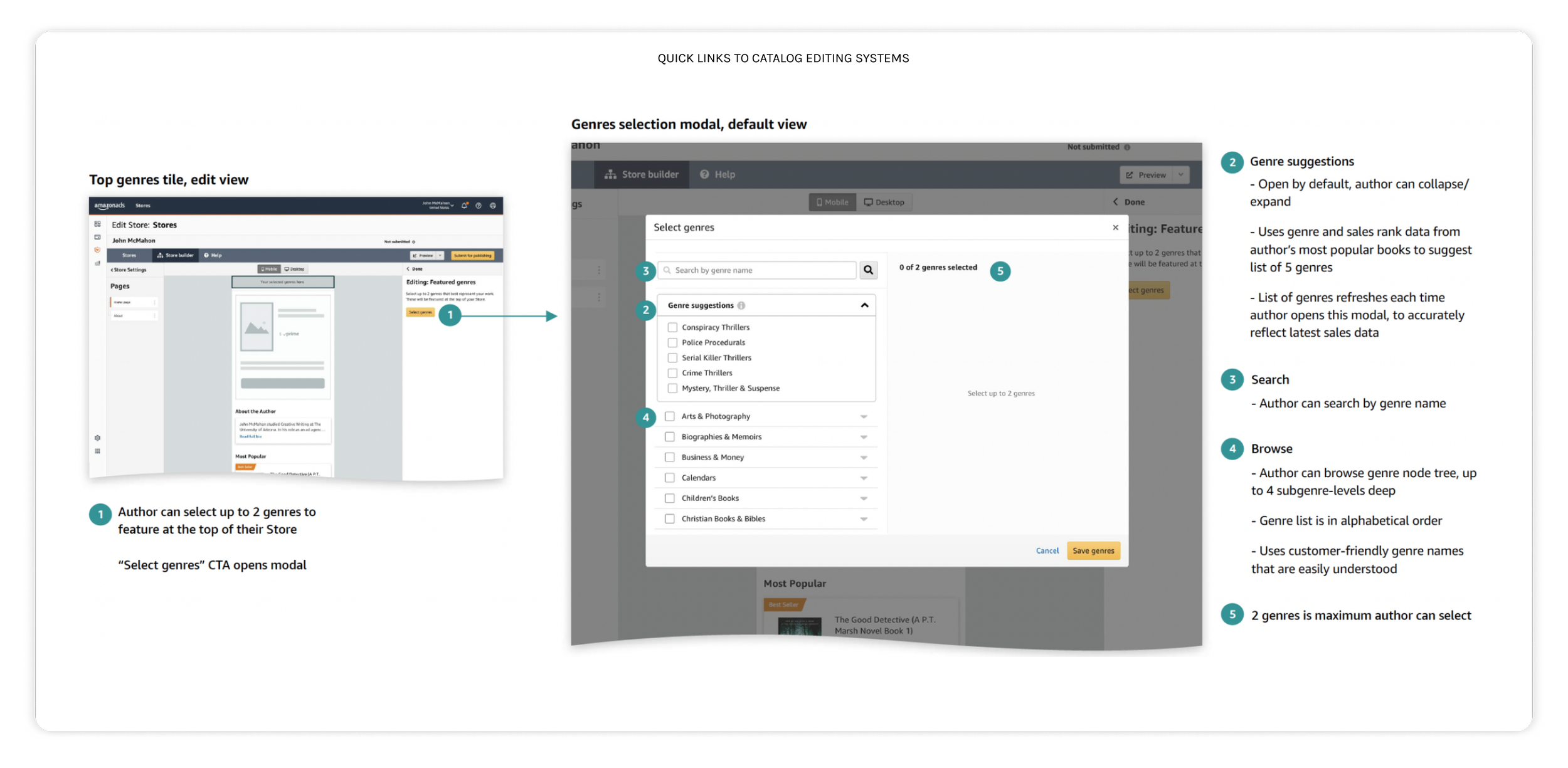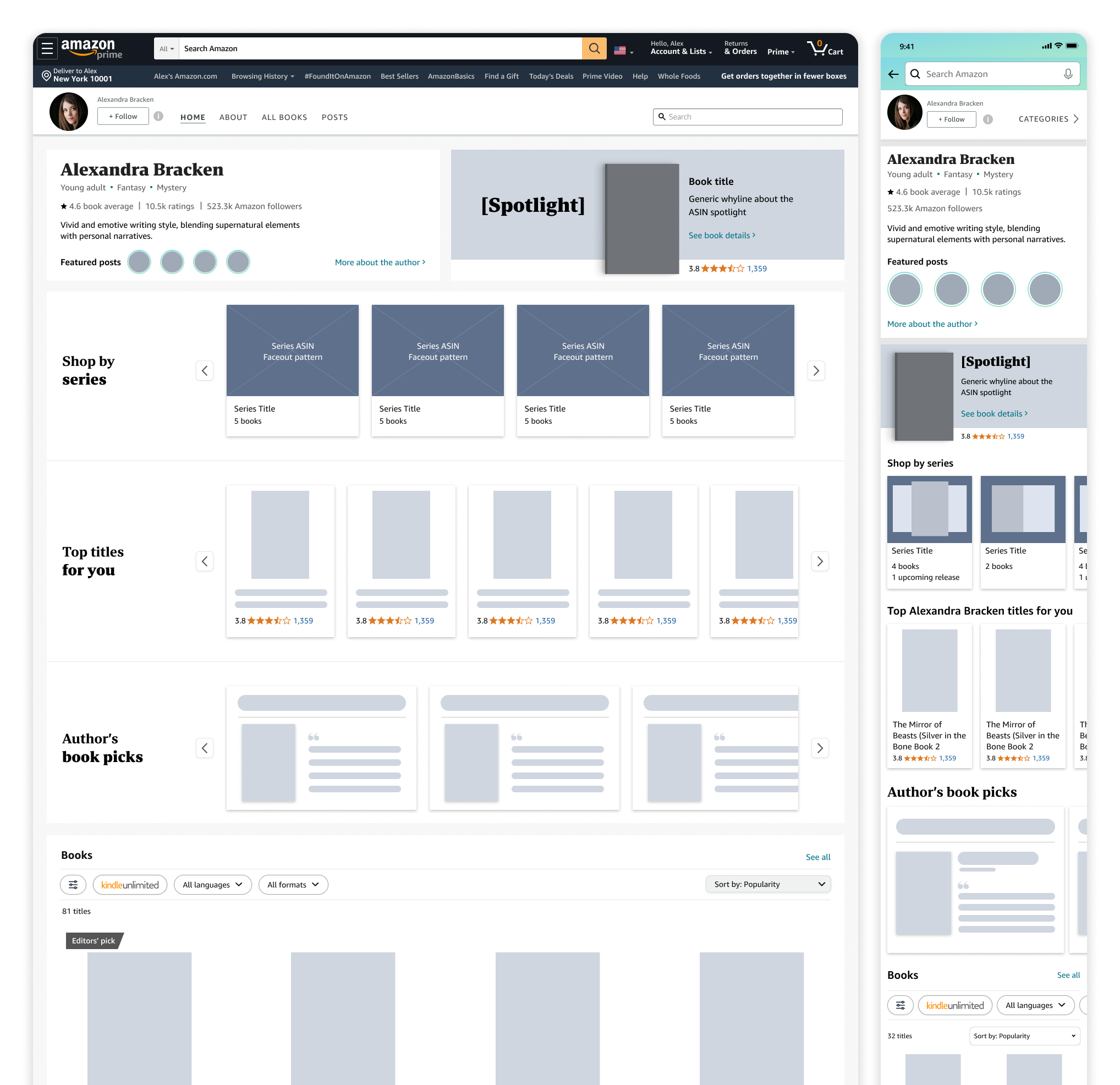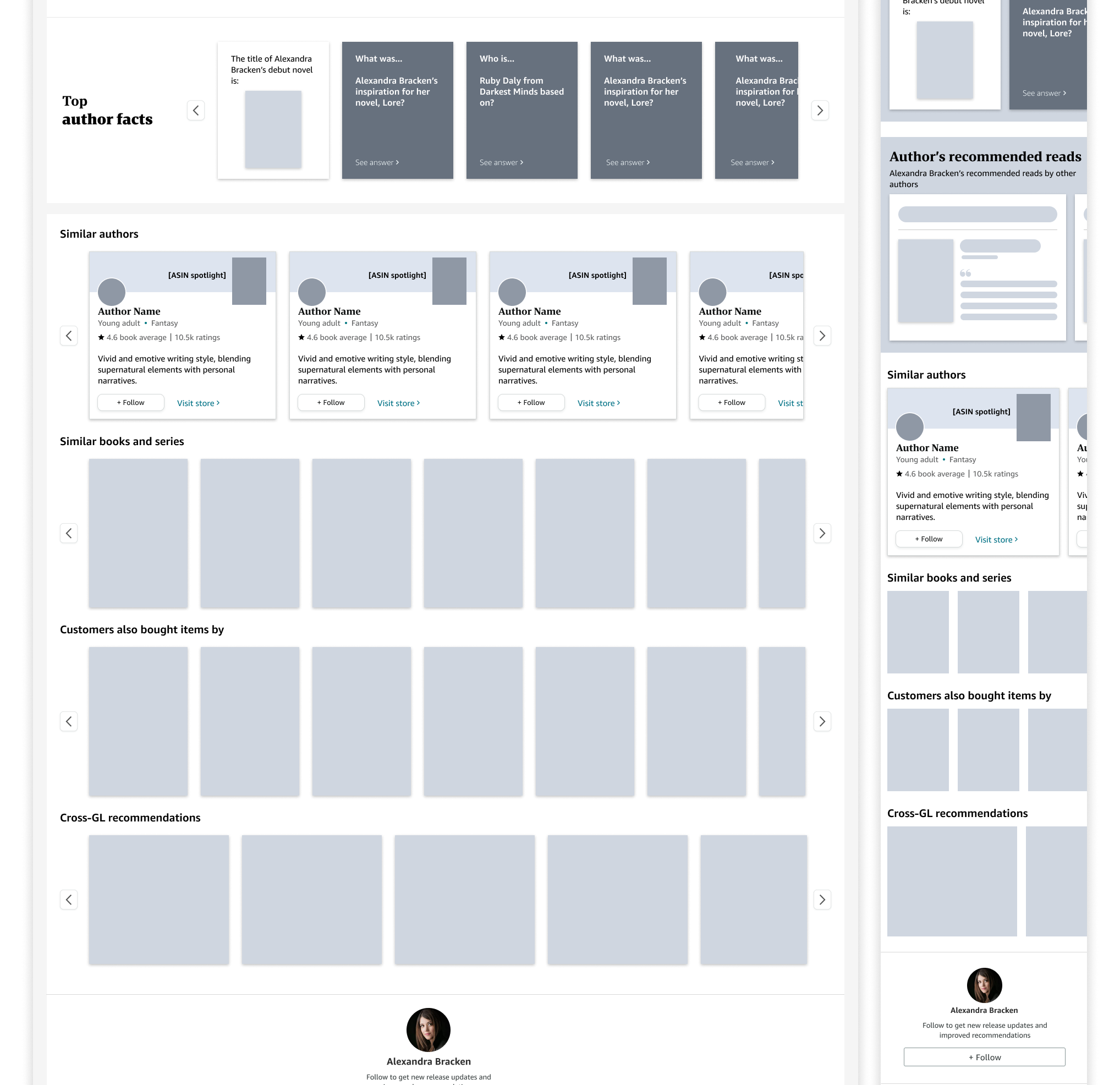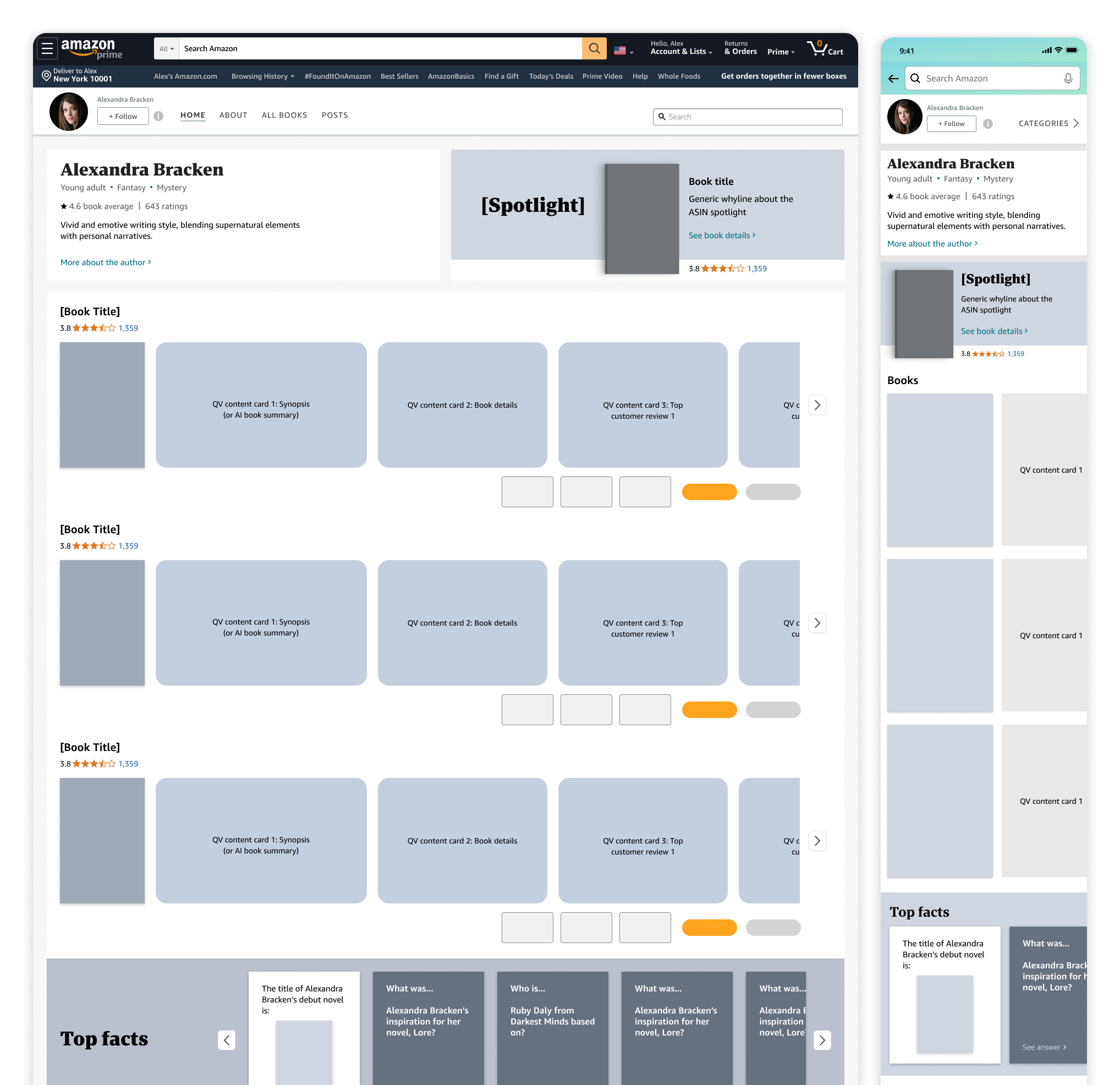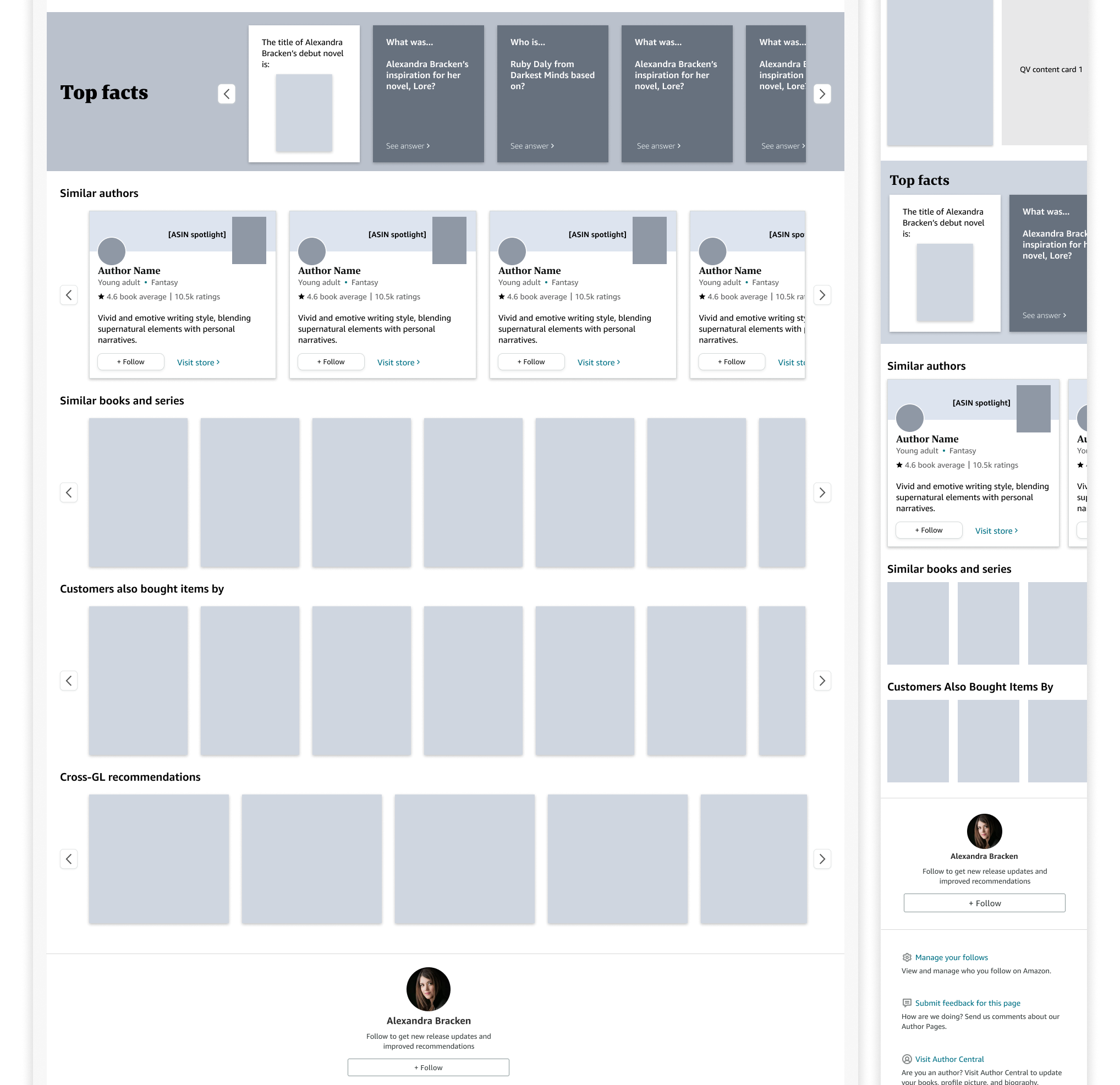AMAZON
Author Stores
BACKGROUNDThis project reimagined the Author Page experience and content approach at scale. The new Author Store centralizes author-curated and Amazon auto-generated content, creating a curated and personalized shopping experience. These customizable storefronts enable authors to uniquely showcase their brand and books, while dynamically responding to shopper signals.
OUTCOMESThis work developed a scalable framework that set up Author Stores as a central surface for content contribution across multiple partner teams, and set the groundwork for future monetization opportunities.
The first milestone launched a baseline auto-generated Store for every author — and drove a 31% increase in books gross sales and 21% increase in books units purchased compared to the previous experience.
ROLEPart of the core team that led the UX vision and end-to-end process, across desktop and mobile. Drove 3-part research series that informed design and product direction.
UX Design, Visual Design, User Research, User Testing, Framework Development
CREDITSSai Gantla, Saray Cohen-Martin, Keila Olbrich, Jenny Xin
Goals-
Create an immersive experience meeting unique author/reader needs
-
Embed authors’ unique voice, engage readers, and drive more conversion
-
Help shoppers find the right read and deepen author-reader connections
-
Create a framework for content contribution at scale
Vision + Framework
A personalized, dynamic Storefront featuring unique author content
The Author Store anchors on the 4 Cs: Customer, Catalog, Content, and Context. Author Stores centralizes content from multiple sources, combining Amazon-auto-generated and author-unique content and dynamically ranking cards across defined page slots to personalize the experience relevant to the shopper’s context, mission, and propensity with the author.
Smart-to-author, smart-to-shopper
The Store template responds to an author’s catalog size. For example, if an author has 1 series in their catalog, the series faceout expands to display all titles within that series by default. If an author has a small catalog (e.g. a handful of titles), the Books product grid swaps for a detailed “showcase” view with purchase options directly inline.
A dynamic, personalized bar anchors the shopper’s past propensity (you’ve purchased X books from this author) or similarity signals to give the shopper confidence when evaluating the author (similar reads, authors, authors they follow). A smart catalog leads with personalized recommendations.
Evolution of a framework for content contributions at scale
As we originally drove toward a new unified author experience that integrated Stores capabilities with previous Author Pages content for the initial launches (“P0”) and MLP, we planned to combine different content types by introducing a content framework. We defined card classifications, the core shopper mission they mapped to, and associated ranking criteria for each.
This P0 framework set up Author Stores as a central surface that teams across the Books organization can contribute to — while ensuring alignment to an overarching strategy based on shopper mission and commonly understood ranking criteria.
This would enable a durable approach to experimentation and introducing new content to the Store at scale.
This work informed the evolution of a 2.0 framework, which creates more opportunities to personalize and monetize the Store experience based on both the shopper and author. Content within each section is ranked to optimize the experience for the individual reader.
Additionally, monetization strategies further optimize the Store through resizing of content type, pinning content types to specific position (e.g. ad continuity with displaying which title the customer came from if they clicked from an ad), and brand customization (e.g. custom assets).
A peek into the process
BEFOREPrevious author pages
Previous Author Pages were built on an aging tech stack and had not seen significant CX updates in several years. These legacy pages were not mobile-optimized, with some sections displaying broken and misaligned, and there were often content inconsistencies between desktop and mobile:
Core catalog browsing functionality, such as book details, buying actions, and filtering, were missing on mobile.
Some content like author blog RSS feeds were seldom used by authors and had low shopper engagement.
Research insights + CUSTOMER NEEDSVoice of the customer
Deepen author-reader engagement — There were signals and voice of the customer that shoppers and authors wanted to connect and engage on a deeper level.
Drive more discoverability and conversion — Stores give authors tools to embed their voice and identity along the shopping journey — which builds trust, attracts new readers, and ultimately leads shoppers to buy books.
Curate an immersive brand experience — Some authors found ‘backdoors’ to creating a Brand Store, which were being leveraged by top brands and generated higher sales. However, they were high-effort to build and maintain, and authors were novice marketers.
EARLY EXPLORATIONS + LAY OF THE LAND DISCOVERYA unified experience
I collaborated closely with my PM partner on a concept document reviewed with cross-org leadership, exploring a vision for a unified experience taking the best of author pages (evergreen content) and Brand Stores capabilities (fresh, up-to-the-moment content). The baseline would be an “always on” Store powered by Amazon, while the enhanced experience had opt-ins that were customizable and author-owned.
I researched how authors would market, brand, and set up their own websites, finding they often had large leading ‘heroes’ for new releases or pre-orders. Branding ranged from custom logos to assets inspired by book covers. Editorial reviews and testimonials were common, as were series cards for larger catalogs.
User RESEARCH #1: SURVEYAuthor’s role in shopper purchase decisions
As a workaround to external research limitations due to the pandemic, we partnered with User Research to run a survey with 600+ “Book Lovers” in an internal community group, in which 72% research or buy a new book weekly.
Genre is a key attribute when deciding on a book purchase — Author’s sub-genres/tropes were consistently marked as “extremely helpful” when deciding on the next book.
Shoppers want to engage with authors on a deeper level — Readers want an author’s book recommendations, are curious about their life goals and values, and want to know how they get inspired.
Amazon can provide greater inspiration for authors — Although 72% followed authors on 1+ social platforms, only 25% found Amazon “extremely inspiring” in providing inspiration for new authors.
REFINING THE VISIONControlled customization — smart to author
Taking survey insights into account, I focused the CX vision around the concept of controlled customization. This direction involved smart-to-author templates based on catalog size. Locked Store areas were consistent within the template and would always be up-to-date, personalized to the shopper, and powered by Amazon data. Opt-in, customizable areas would be curated by the author — these would help authors build a rich brand presence and help shoppers more deeply engage.
A smart-to-shopper slot dynamically pulls in the most relevant content based on: 1) shopper’s past interactions and propensity with this author’s books; and 2) availability of recent author-curated content.
User RESEARCH #2: USABILITY STUDYTesting with shoppers
We partnered with User Research to test prototypes with 18 shoppers who regularly shopped for books on Amazon. Shopper impressions of Author Stores were positive; when asked to rate the prototype vs. previous Author Pages (1=much worse; 5=much better), Author Stores was rated 4.8/5.
The Store provided confidence in decision making, with shoppers feeling like they have enough information to gauge interest in the author or one of their books.
The ‘hero’ for a new release, biography, and accolades badges provided confidence that the author was active and had well-rated work.
While positive accolades lent to credibility, shoppers seeked a more balanced perspective. They felt the author is unlikely to display negative reviews.
Shoppers wanted more refinement options, like language and age group filters.
STORE BUILDER EXPLORATIONS + WORKFLOWSAuto-generation + keeping a low barrier-to-entry
Research told us authors were novice marketers and wanted to spend less time in marketing tools. I envisioned auto-populating as much Store content as possible with what authors had already provided across Amazon systems. The Builder would pre-determine the template based on catalog size, and authors opt-in to pre-defined customizable areas.
Authors deal with 3 main Amazon touchpoints: 1) Author Central, 2) KDP portal, and 3) Amazon Ads portal, where the Stores builder lived. Partnering closely with these partner teams, I mapped out how we envisioned authors would ingress into the Store Builder, capturing a unified mapping of an author coming in from any of the 3 entry points in a holistic view. How to handle validating rightful ownership of a book/author name for Store eligibility, and making Store creation and new feature announcements present across touchpoints, were key considerations.
User RESEARCH #3: 1:1 INTERVIEWSTesting with authors
My PM and I conducted moderated sessions with 11 authors of mixed catalog size, genre, and series. Each author interacted with customized prototypes, so they could see their own books in the new experience.
Overall, authors had positive impressions, noting a comprehensive improvement to Author Pages (which felt more cluttered and less engaging).
“This would be great for building my brand, and promoting my brand as a one-stop shop to buy my books” — Authors saw the Store as a comprehensive and easy-to-navigate destination, with more abilities to bring their author voice.
“Amazon’s doing the heavy lifting for you. I can immediately tell this is optimized for conversion, which as an author makes me happy” — Those with limited resources and technical expertise liked that Stores saved them time rather than manually update and upkeep their own website. Authors found Stores valuable in driving purchases and preferred pointing shoppers to where it’s easier to do so.
All authors found auto-population to be useful and a time-saver, but expected levels of customization varied. Some authors wanted more control over Store ordering, while others trusted Amazon’s ability to optimize. All authors understood the concept of controlled customization.
INitial pilot testPiloting a lean experience
The pilot CX we launched was a lean experience, focused on the baseline Store and core catalog browsing functionality that we could auto-generate across all authors. This included 2 sub-pages: a simple About page housing the author’s full biography and a utility-focused All Books page.
We tested this Store CX in an experiment with 3K authors, allowing us to move quickly and test the default Author Store against existing Author Pages, and isolate impact of new CX features introduced thereafter.
In-Stores Quicklook
The ‘Quick look’ icon on the lower-left of book covers opened a modal or bottom sheet with more details. Shoppers can view book details and add to cart without leaving the Store, easing the need to ping-pong between multiple Detail Pages.
A PIVOT IN SCOPE + SEQUENCINGFocusing on a baseline shopper-facing experience
After the CX pilot, original plans were to launch a Store Builder pilot with a small set of authors — but this unfortunately got de-scoped for 2 key reasons: 1) tech resource constraints, and 2) the CX pilot performed well against Author Pages, without any customizations yet, that we felt confident prioritizing a GA launch of that baseline experience first.
CARDS BRAINSTORM WITH BOOKS PARTNERSDefining the P0 content framework
As we were ramping to launch the P0 baseline experience at a wider scale, our Books partners had started work developing and collecting new “cards” content that could be reusable across books pages, including Author Stores. The first 2 cards included: 1) a personalized ‘smart' catalog; and 2) author-curated book recommendations, but there would be more content introduced in the future.
I co-ran brainstorming sessions with Books product + design partners on how we might integrate this new content in the Store. This informed our approach for a P0 cards framework and content prioritization across Store pages as we scale.
Applying the Cards framework to the P0 Store
Applying the framework, our MLP experience ranked author-curated and Amazon-generated cards. The sections highlighted in orange mark how the first set of cards content planned to be introduced to the P0 Store, as well as how other auto-generated content would be classified and ranked.
Initial MVP launch in US
Launching the first Author Stores milestone migrated 1.3MM+ legacy author pages in the US to a baseline auto-generated Store experience. The MVP that we launched included several updates + improvements: 1) simplified versions of the personalized smart catalog and author’s book recommendations; 2) more robust catalog filtering; and 3) beginning seeds of better customer awareness.
Impact
In the first 30 days, with 21.3MM visits across 1MM+ author stores, we observed:
+31% increase in attributed books sales
+21% increase in attributed units purchased
MVP launch worldwide
We then launched the experience across worldwide marketplaces, languages and currencies. This included the “EU5” markets (UK, France, Italy, Germany, Spain) as well as Canada, Mexico, Brazil, India, and Australia.
Impact
This expanded Stores from 1.2MM to 3.8MM+ authors, migrated 360MM+ annualized traffic to Stores, and supported the launch of Stores as a landing page to drive ads demand. Feature improvements drove:
+6.5% increase in attributed books sales
Future vision and evolution
Learnings and Author Stores 2.0
Post worldwide launch, we worked closely with our Books team partners to evaluate how the Store could evolve into a 2.0. A few factors influenced this new direction (seen at the top of this case study).
More content centralization + integration — Integrating content we weren’t able to in the MVP yet, like series, trending books data, content from other sources like Goodreads
Better personalized signals — Based on your past propensity with an author, as well as better author-to-author and book-to-book similarity.
Books design system — At this point, a wider Books design system was starting to be introduced on other key books surfaces. We aimed for Stores to align with these components and styles for a holistic experience across Books touchpoints.


